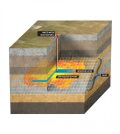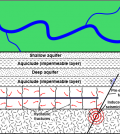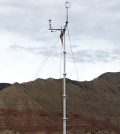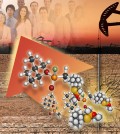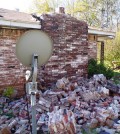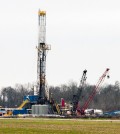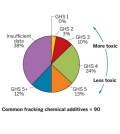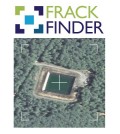Posts for tag "fracking"
No Evidence of Natural Gas From Fracking In Ohio Drinking Water
Time-series research reveals no evidence of natural gas contamination from fracking in Ohio drinking water wells.
- Posted August 13, 2018
State Oil and Gas Regulations are Inadequate, Leaving Groundwater Vulnerable
New research indicates that oil and gas regulations surrounding hydraulic fracturing are inadequate to protect underwater drinking water sources.
- Posted March 26, 2018
Modeling Wastewater Injection Effects to Better Understand All Seismic Activity
Research has generated a model for predicting the magnitude of seismic activity triggered by wastewater injection—a report on a natural seismic experiment.
- Posted January 30, 2018
Impact of Microorganisms in Fracking Processes May Have Been Underestimated
Harmful pathogenic bacteria has been found in groundwater near fracking sites in Texas, suggesting new remediation strategies for evaluation.
- Posted January 2, 2018
Levels Of Methane In Groundwater Vary With Fracking Well Construction
University of Cincinnati scientists lead a study of methane in groundwater surrounding fracking wells to pinpoint where the gas originates.
- Posted August 11, 2016
Air Quality Near Fracking: Highest Emissions During Flowback
Colorado State U. scientists complete a study of emissions from gas wells in Garfield County, Colo., where air quality near fracking is a big concern.
- Posted July 13, 2016
Soil, Water Contamination In North Dakota From Fracking Spills
Duke University scientists find water and soil contamination caused by wastewater spills from hydraulic fracturing in the Bakken region of North Dakota.
- Posted May 12, 2016
Fracking Fluids, Wastewater Full Of Toxins
A new study reveals fracking fluids are fraught with toxins, according to a release from Yale University. The study is an important step toward future studies to identify and rank the toxicity of chemicals found in fracking...
- Posted January 11, 2016
Study Looks At Probability Of Methane Leakage From Hydraulic Fracturing
University of Vermont scientists complete the first quantitative study of methane leakage from existing hydraulic fracturing sites to abandoned wells.
- Posted November 9, 2015
Yale Study Links Organic Compounds In Pennsylvania Drinking Water To Surface Fracking
Researchers at Yale University have found that the presence of organic compounds in groundwater aquifers overlying the Marcellus Shale don’t come from deep shale layers or gas wells, according to a release. Instead, the scientists say that...
- Posted October 13, 2015
EPA: No Broad-Scale Drinking Water Pollution From Fracking
After a long-term look into the effects of hydraulic fracturing, or “fracking,” officials at the U.S. Environmental Protection Agency have found the practice is likely not polluting drinking water supplies, according to National Public Radio. They say...
- Posted June 12, 2015
Drexel Scientists Assess Air Quality Effects Of Extracting Marcellus Shale Gas
Scientists at Drexel University use a mobile air quality lab to assess methane and air pollutants around gas industry sites in northeast and southwest Pennsylvania.
- Posted June 11, 2015
USGS marks Oklahoma as ‘earthquake country’ due to fracking risk
The U.S. Geological Survey has declared 17 new regions in Oklahoma as earthquake country, designating much of the state as at-risk for seismic activity, Reuters reported. The new designations are part of the first official map by...
- Posted May 6, 2015
Around 700 chemicals can appear in fracking fluid, EPA finds
A new EPA study reported in The Hill reveals that there are approximately 700 chemicals in fracking fluid, some of which may be hazardous. The EPA used data provided by industry over the course of two years...
- Posted April 23, 2015
Biocides, other organic compounds identified in fracking fluid study
New studies show biocides and other organic chemicals are among the poorly understood constituents of fracking fluid, according to a press release from Elsevier, publisher of the journals the studies appear in. The studies’ revelation that there...
- Posted April 17, 2015
Hidden faults tied to increased earthquakes in states with fracking activity
Two new studies explain why frequent earthquakes are more likely in some fracking zones, according to a Live Science article. The first study analyzed nearly 4,000 earthquakes in Oklahoma to detect both unknown and known faults, finding...
- Posted March 2, 2015
EPA faces lawsuit for not requiring fracking chemicals to be named
Nine environmental groups are suing the EPA for not requiring oil and gas drilling companies to report the names of key hazardous fracking chemicals into the publicly accessible Toxic Release Inventory Database, according to a report from...
- Posted January 29, 2015
New fracking forum pledges to reduce environmental impact
Concerned by the effects of fracking, several groups have banded together to create a new forum designed to improve the environmental and economic impacts of fracking, according to a recent article in Chemical and Engineering News. The...
- Posted December 19, 2014
Without public info, researchers track fracking sites through satellite images
Researchers and concerned citizens are watching Pennsylvanian hydraulic fracturing sites from above, according to a recent report from Smithsonian magazine. John Hopkins scientists have been looking for a connection between poor health and chemical exposure by tracking...
- Posted November 21, 2014
Novel groundwater monitoring near fracking underway by University of Cincinnati
An innovative approach to groundwater monitoring is underway at the University of Cincinnati, according to a release from the university. Researchers are working to take measurements before, during and after fracking activity in some areas in Ohio....
- Posted November 5, 2014




